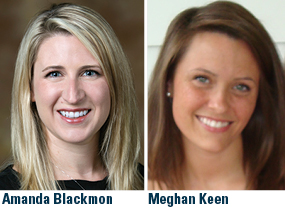
When Meghan Keen, (Physical Therapy, 2013) had an opportunity to complete a directed study during the third year of her Doctor of Physical Therapy (DPT) study, she leapt at it — quite gracefully, with her toes pointed. An undergraduate dance major, Keen arranged a directed study under the advisement of Emory alum Amanda Blackmon, DPT, OCS. Blackmon, a former dancer herself, is a therapist at One on One Physical Therapy where she treats dancers as well as other patients. She also contracts with professional performing artists on tour.
Keen actually contacted Blackmon during her first year at Emory. "When she got to Atlanta, Meghan Googled 'dance medicine' and found me," says Blackmon. "Initially, she came with me when I was providing backstage coverage for "Hair: The Musical" when it toured Atlanta. It was great having her along — she had a very strong interest in dance medicine and she was so smart and so motivated."
So when she had a chance to fashion a directed study to pursue her specific interest, Keen naturally turned to Blackmon. In Blackmon, Keen found a valuable mentor to guide her in treating the very specific types of injuries suffered by dancers. "To effectively treat a dancer, you have to really understand the physical demands placed on them," says Blackmon. "They get very specific injuries. Most dancers present with hypermobility, and can be difficult to assess because they work outside a normal range of motion."

Keen, who now practices in an outpatient orthopedic clinic in Roaring Spring, PA, brought quite a bit of experience to the table herself. She studied dance at the University of North Carolina at Charlotte and planned to pursue dance professionally after graduation. When several injuries derailed her dream of dancing professionally, Keen decided to pursue dance medicine.
"I had been interested in physical therapy for some time," says Keen. "My first semester as a dance major I was enrolled in a dance kinesiology course, and it just clicked for me. Although I never worked with a physical therapist to rehabilitate any of my own injuries, I realized there was a gap between the needs of injured dancers and the healthcare available to help them return to high functioning dance-specific daily regimens."
During her two semesters with Blackmon, Keen taught patients dance-specific and Pilates-based exercises, as well as observed the hands-on treatment they received from Blackmon while treated at One on One Physical Therapy, on site at local dance studios, and backstage during the 2012 "So You Think You Can Dance" Tour. She also revamped Blackmon's injury prevention workshops and presented them to local dance studios, a local performing arts high school, to dance majors at the University of Georgia and the Emory University Dance Company.
The highlight of their time together grew out of a patient they saw from the Decatur School of Ballet, who suffered an acute ankle sprain. "She was scheduled to perform two weeks after her injury," says Blackmon. "We stayed away from the treatments traditionally used to treat such injuries. Instead, we used Pilates-based exercises to strengthen her core and gluteus muscles. We also used taping, muscle energy techniques, soft tissue mobilization, and specific joint mobilizations. We treated her six times over two weeks, and just two weeks after her accident she was able to perform en pointe (in shoes that support the entire body on the tips of the toes)."
Encouraged by the success of their treatment, Blackmon and Keen submitted it as a case study to the International Association for Dance Medicine and Science (IADMS). The paper was accepted, and Blackmon and Keen will be presenting it at the IADMS annual meeting in Seattle in October.
